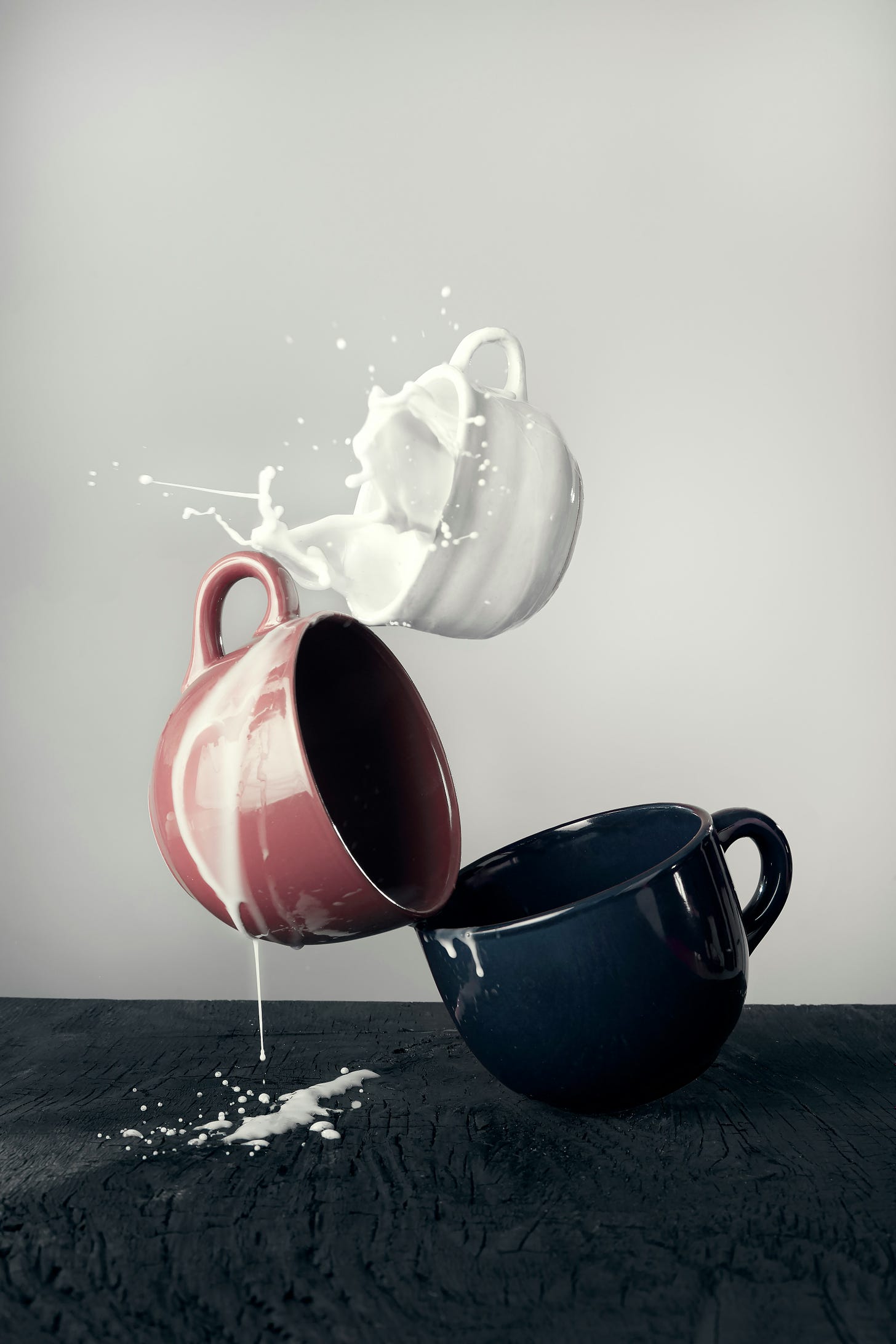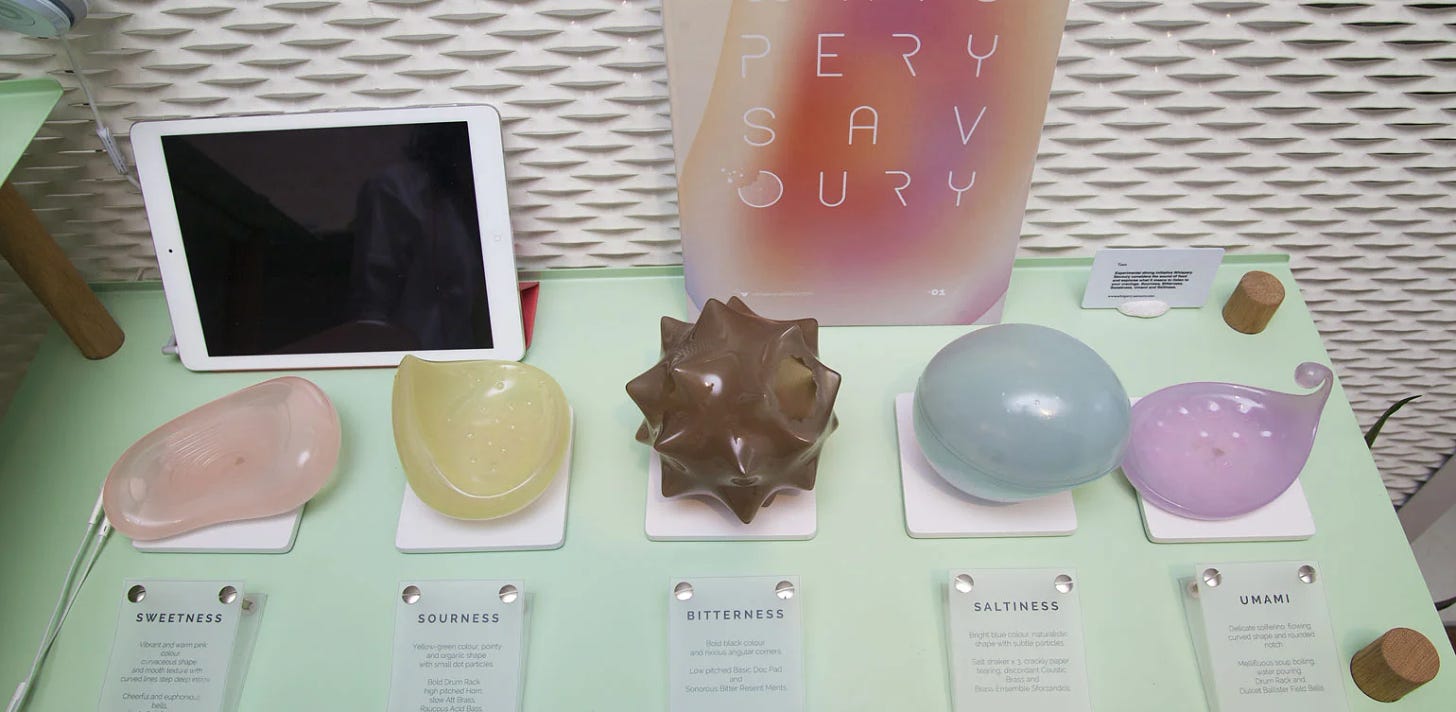Shaping the Multisensory Experience: How Design Influences Taste, Smell, and Perception in Food and Beverages
The UX Psychology of Food and Drink
I have a confession to make; I’m a foodie. I spend a lot of time and effort thinking about food and coffee related things. You can say it’s one of my special interests... This post is an attempt to view this through a UX psychology lens.

The experience of eating and drinking is inherently multisensory, engaging not just our taste buds and nose, but also our eyes, ears, and even our sense of touch. In recent years, researchers have increasingly focused on how the design of food and beverage packaging, serving vessels, and dining environments can influence our perception and enjoyment of what we consume (e.g., Spence & Piqueras-Fiszman, 2014). This growing body of research highlights the crucial role that design plays in shaping our multisensory experiences with food and drink.
In this article, we'll explore some of the fascinating ways in which design elements like shape, colour, and texture can affect our perception of taste, aroma, and flavour. We'll delve into recent studies on the impact of cup and glass shape on the experience of drinking coffee, wine, and beer, and examine how individual differences and expertise can modulate these effects. We'll also look at the psychological mechanisms behind these phenomena, such as crossmodal correspondences, and consider how we can apply these insights to create more engaging and enjoyable food and beverage experiences.
The Power of Shape
One of the most intriguing areas of research in this field focuses on how the shape of drinking receptacles can influence our perception and enjoyment of beverages. In a study by Carvalho and Spence (2018), both amateur and expert coffee drinkers were asked to rate the aroma, sweetness, acidity, and overall liking of specialty coffee served in three different cup shapes: tulip, open, and split. The cups used were the Oslo cup series from Figgjo 193 (Figgjo, Oslo, Norway) designed by Kristin Hærnes Ihlen together with Tim Wendelboe in order to enhance the coffee drinking experience. Figgjo won the Red Dot Design Award in 2016 with this cup series! The cups were chosen because ‘shape’ was the only factor that varied between them. All cups were made of the same material, and had the same texture, colour, height, and virtually the same weight.

The results were striking. The tulip-shaped cup, with its narrow opening and curved body, was found to enhance the perceived intensity of the coffee's aroma compared to the open and split cups. This effect was observed in both amateur and expert drinkers, suggesting that the shape of the cup can have a powerful influence on how we experience the aroma of coffee, regardless of our level of expertise.
Interestingly, the split cup, which features a more rounded shape with an indentation in the middle, led to higher ratings of sweetness and acidity compared to the tulip and open cups. This finding suggests that the shape of the cup can also influence our perception of specific taste qualities in coffee.
When it came to overall liking, the results were more nuanced. While the open cup received the highest liking ratings from amateur drinkers, experts showed a preference for the coffee served in the split cup. This highlights how individual differences in expertise and familiarity with a product can modulate the impact of design on our hedonic experiences.
These findings align with research on other beverages, such as wine (Hummel et al. (2003) and beer (Mirabito et al., 2017), which has also demonstrated the significant influence of glass shape on aroma, flavour, and hedonic judgments. For example, Hummel et al. (2003) found that serving wine in a bulbous glass led to higher ratings of aroma intensity compared to serving it in a straight-sided glass. Similarly, Mirabito et al. (2017) found that beer served in a curved glass was perceived as fruitier and more intense than the same beer served in a straight-sided glass.
The Influence of Colour
In addition to shape, colour is another design element that can have a profound effect on our perception and enjoyment of food and beverages. Numerous studies have shown that the colour of a product's packaging, label, or serving vessel can influence people's expectations and experiences of taste, aroma, and flavour.
A recent study by Carvalho and Spence (2019) investigated the effect of cup colour on consumers' expectations and experiences of specialty coffee. In a series of experiments, participants evaluated coffee served in cups of different colours (white, pink, yellow, and green) before and after tasting. The results showed that cup colour significantly influenced both expected and perceived sweetness and acidity. For example, coffee served in a pink cup was expected to be sweeter and less acidic, and these expectations carried over to the actual tasting experience when the coffee was indeed sweet. However, when a more acidic coffee was served in the pink cup, the unexpected acidity was enhanced, leading to lower liking ratings.
Interestingly, the study also found that the yellow cup increased both sweetness and acidity ratings compared to the white cup, suggesting cross-cultural effects on colour-taste associations. In Brazil, where the study was conducted, yellow fruits like mangoes and bananas are abundant and associated with sweetness, which may explain this finding.
These results align with previous research demonstrating the influence of colour on taste and flavour perception. For instance, a classic study by Morrot, Brochet, and Dubourdieu (2001) found that wine experts used more red fruit-related terms to describe a white wine that had been dyed red, compared to when they tasted the same wine in its original white colour. This suggests that the colour of the wine can strongly influence our perception and description of its flavour, even among experts.
In another study, Zellner and Durlach (2003) found that people expected clear beverages to be more refreshing than darker-coloured ones, and that this expectation influenced their actual experience of the beverages. Participants rated a clear lemon-lime drink as more refreshing than a darker cola-coloured drink, even though the two drinks were identical in taste.
The findings from these studies highlight the importance of considering colour in the design of food and beverage packaging and serving vessels. By choosing colours that align with the desired sensory qualities and consumer expectations of a product, designers can enhance the perceived taste, aroma, and overall experience of consumption.

Crossmodal Correspondences and the Role of Expectation
But how do design elements like shape and colour influence our perception of taste and aroma? One key mechanism behind these effects is a phenomenon called crossmodal correspondences. This refers to the natural and often surprising associations that our brains make between different sensory modalities, such as sight and taste, or hearing and smell (Spence, 2011).
For example, many people associate round shapes with sweetness, while angular shapes are more often linked with sourness or bitterness (Velasco et al., 2016). Similarly, certain colours are consistently matched with specific tastes, such as red with sweetness and green with sourness (Spence, 2015). These crossmodal correspondences can shape our expectations about the sensory qualities of a food or beverage before we even taste it.
In the study by Carvalho and Spence (2018), the finding that coffee served in the split cup was rated as sweeter and more acidic than coffee served in the tulip or open cups may be partly explained by the roundness of the split cup's shape. The rounded shape of the cup might have primed participants to expect a sweeter taste, which then influenced their actual perception of the coffee's flavour.
The role of expectation in shaping our sensory experiences is well-established in the literature. When we see a particular shape, colour, or other design element on a food or beverage product, it can trigger a set of expectations about how that product will taste, smell, and feel in the mouth. These expectations can then influence our actual sensory perception and evaluation of the product, either by enhancing or detracting from the experience.
This is why it's so important for designers to consider the crossmodal correspondences and expectations that their design choices may evoke in consumers. By aligning the visual and tactile elements of a product with the desired sensory qualities, designers can create packaging and serving vessels that enhance the overall multisensory experience of consumption.
Individual Differences and Expertise
While the effects of design on sensory perception are robust and widespread, it's important to recognise that individual differences can also play a role in shaping these experiences. Factors like culture, age, gender, and expertise can all modulate how we perceive and respond to the sensory qualities of food and beverages.
In the study by Carvalho and Spence (2018) described earlier, expert coffee drinkers showed a different pattern of preferences than amateur drinkers, with experts preferring the coffee served in the split cup and amateurs favouring the open cup. This suggests that a person's level of experience and familiarity with a product can influence how they perceive and evaluate its sensory qualities in different contexts.
Other studies have also highlighted the role of expertise in shaping sensory perception. For example, Parr, Heatherbell, and White (2002) found that wine experts were more accurate than novices at identifying the aroma of Chardonnay wines, but only when the wines were presented in clear glasses. When the wines were presented in black glasses, the experts' advantage disappeared, suggesting that visual cues play a key role in wine aroma identification, even for highly trained individuals.
Cultural background is another important factor to consider. In a study by Wan et al. (2015), participants from China, Korea, and the United States all showed similar effects of glass shape on their perception of alcoholic drinks, but the strength of these effects varied across cultures. This highlights the need for designers to be aware of cultural differences in sensory perception and to tailor their designs accordingly.
Implications for UX and Beyond…
The research on how design influences taste, smell, and perception in food and beverages has important implications for UX professionals working in this domain. By understanding the complex interplay between sensory modalities, crossmodal correspondences, and individual differences, we can create products and experiences that optimise the sensory enjoyment and engagement of their target consumers.
Here are some things to consider:
Conduct thorough user research: To create designs that resonate with your target audience, it's essential to understand their sensory preferences, expectations, and cultural background. Use methods like interviews, focus groups, and sensory testing to gather insights into how your users perceive and experience different sensory qualities in your product category.
Collaborate with sensory experts: Work with professionals in fields like sensory science, food science, and gastronomy to identify the key design elements that can enhance the desired sensory qualities of your product. For example, a food scientist might help you choose packaging materials that optimise the preservation and delivery of key aroma compounds.
Leverage crossmodal correspondences: Use your understanding of the natural associations between different sensory modalities to create designs that align with consumer expectations and enhance the desired sensory qualities of your product. For example, if you're designing packaging for a sweet and creamy dessert, you might choose round shapes and warm, appetising colours to evoke the expected taste and texture qualities.
Consider the multisensory context: The sensory experience of a food or beverage product extends beyond just the product itself. Consider how the design of the packaging, serving vessel, and consumption environment can all contribute to the overall multisensory experience. For example, a well-designed coffee cup that enhances the aroma and flavour of the beverage can be further complemented by the atmosphere and ambiance of the café in which it is served.
Test and iterate with users: As with any UX design process, it's crucial to test your designs with real users and gather feedback on their sensory experiences.



